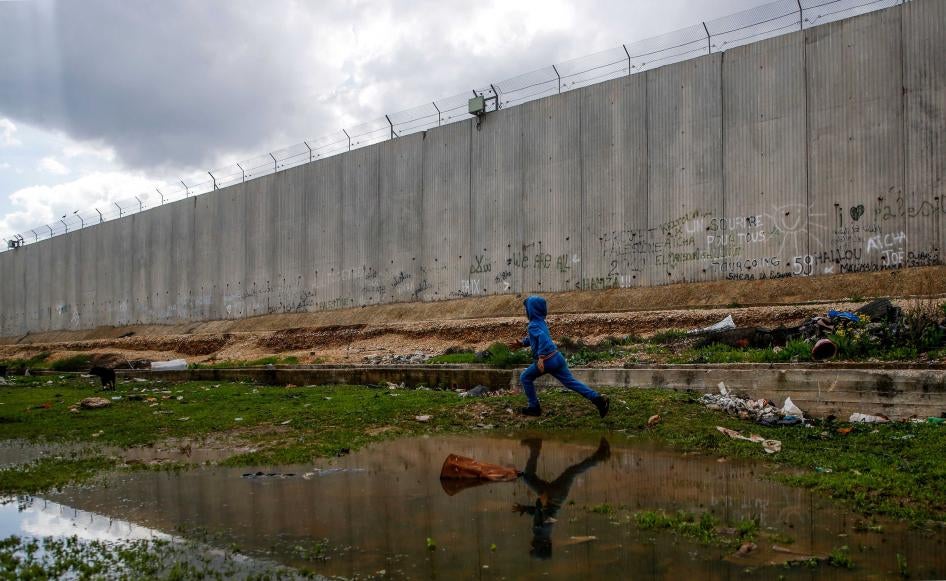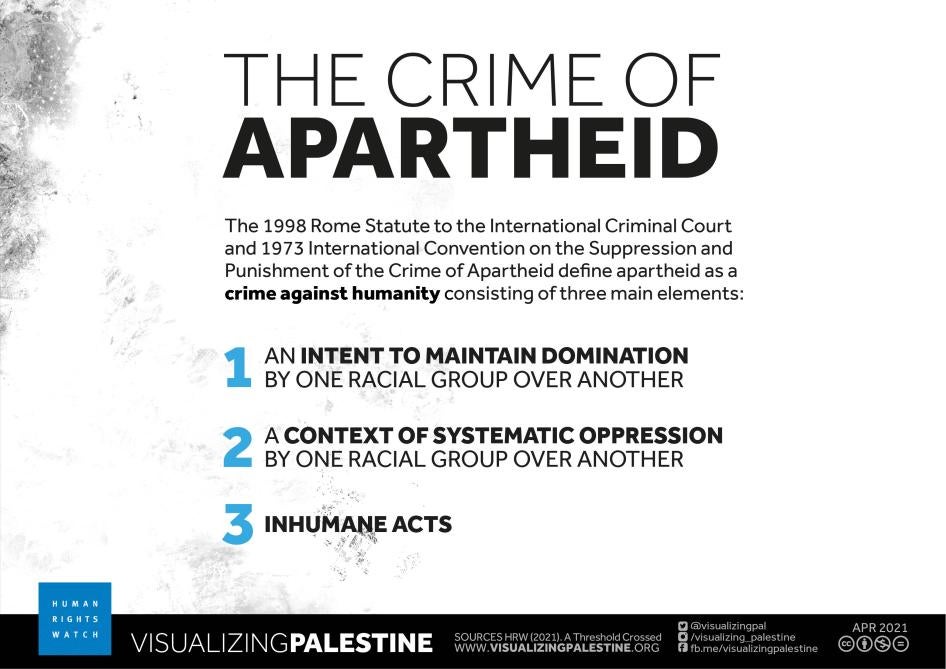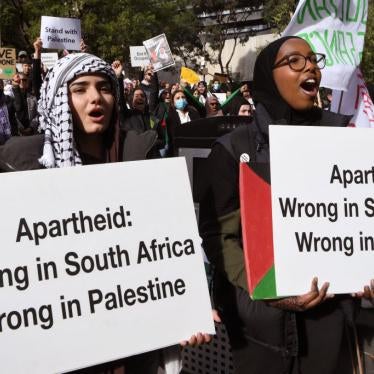We appreciate the rich discussion triggered by this week’s EJIL Talk! symposium, which has addressed a number of legal issues arising from our report “A Threshold Crossed: Israeli Authorities and the Crimes of Apartheid and Persecution.” The report has received significant media attention and sparked many useful conversations since its release in late April. But this forum offers the first opportunity for us to contribute to a substantive discussion focusing primarily on the implications of our report for the broader international legal discourse.
The contributions over the past week drew attention to several key themes, which we address here. We look forward to a robust exchange on these and other issues in the days and months to come, including:
- The conventional and customary definitions of the crime against humanity of apartheid, including the definition of “racial group”; and the influence of international human rights law, especially the International Convention on the Elimination of All Forms of Racial Discrimination (ICERD), on such definitions;
- The distinction between the use of the term “apartheid” as an international legal term and as a historical or comparative concept and the validity of comparisons with 1970s South Africa;
- The validity of a defence of “reasonableness” for apartheid; and
- The temporal and geographical scope of the application of the crime in the context of Israel and Palestine.
Before diving in, a word about the Human Rights Watch mandate, since a number of the issues raised by contributors relate to our methodology and how we conduct research and advocacy.
Human Rights Watch works in nearly 100 countries. Our work involves documenting facts and applying the law to expose abuses and press for change, including in situations in which state officials are credibly implicated in serious international crimes. Our mandate is grounded in international law, mainly international human rights law, international humanitarian law and international refugee law, as well as international criminal law.
Our detailed review of the facts on the ground led us to determine, for example, in 2020, that the authorities in Myanmar were committing the crimes against humanity of apartheid and persecution, among others, against ethnic Rohingya in Rakhine State. And we found in April 2021 that Chinese government officials are committing crimes against humanity, including the crime of persecution, against Uyghurs and other Turkic Muslims in Xinjiang. This same approach underpinned our work on Israeli officials’ responsibility for the crimes against humanity of apartheid and persecution.
- Defining apartheid as a universal legal term, in treaty and custom
Human Rights Watch based its findings on the definition of the crime against humanity of apartheid in international criminal law.
Two international treaties, the Convention on the Suppression and Punishment of the Crime of Apartheid (Apartheid Convention) and the Rome Statute of the International Criminal Court (Rome Statute), identify apartheid as a crime against humanity. The Apartheid Convention defines the crime against humanity of apartheid in Article II as “inhuman acts committed for the purpose of establishing and maintaining domination by one racial group of persons over any other racial group of persons and systematically oppressing them.” The Rome Statute defines apartheid in Article 7, paragraph 2(h) as: “inhumane acts… committed in the context of an institutionalized regime of systematic oppression and domination by one racial group over any other racial group or groups and committed with the intention of maintaining that regime.”
The State of Palestine acceded to these treaties in 2014 and 2015, respectively, and accepted (by way of declaration under article 12(3) of the Rome Statute) the ICC’s jurisdiction as of 13 June 2014. In February 2021, the ICC’s Pre-Trial Chamber I confirmed the court’s jurisdiction over war crimes and crimes against humanity committed in the Occupied Palestinian Territory. (OPT). The State of Palestine’s accession to both the Apartheid Convention and Rome Statute not only gives a legal basis in treaty to the application of the relevant crimes on the territory but also provides legal remedies in the form of possible prosecutions at an international court, in light of the ongoing investigation by the prosecutor of the ICC.
Human Rights Watch found that the definitions of the crime of apartheid under both the Apartheid Convention and the Rome Statute were met in the context of Israeli officials’ actions. While there are differences between the definitions as we set out in our report, they largely overlap. To both explain the crime in terms understandable to the general public and organize the analysis, we distilled the crime of apartheid into three primary elements: (1) an intent to dominate by one racial group over another; (2) systematic oppression by the dominant group over the marginalized group; and (3) inhumane acts. Joshua Kern challenges this summary as a “Human Rights Watch definition,” but our findings apply to and are based on both treaty definitions.
An alternative source to treaties in international law is custom. Israel has ratified neither the Rome Statute nor the Apartheid Convention. Kern’s analysis challenges the status under customary international law of the crime of apartheid.
While there is indeed debate on the customary status of the crime against humanity of apartheid, the prohibition against apartheid under public international law and international human rights law has reached customary status. Moreover, the International Law Commission (ILC) recognized the prohibition of apartheid, like the prohibition of racial discrimination, as a peremptory norm of public international law. Additionally, as Kern himself notes, the “near universal ratification” of the ICERD leaves the prohibition “beyond doubt” in international human rights law.
However, the term apartheid in ICERD has not yet been clearly defined. The Committee on the Elimination of Racial Discrimination (CERD) recently confirmed the admissibility of an inter-state communication by the State of Palestine against Israel. Palestine’s original 2018 complaint includes, among other claims, alleged violations of article 3 of the ICERD, which covers racial discrimination and apartheid. Soon, an ad hoc Conciliation Commission will review the merits of its claims, including Israeli state responsibility for internationally wrongful acts under the convention. This may be an opportunity to define the meaning of apartheid under ICERD.
But reverting to customary international law was not necessary in the Human Rights Watch report, where we used apartheid under its definition in international criminal law set out in treaties ratified by the State of Palestine.
Carola Lingaas focuses her intervention on the definition of “racial group.” She agrees with Human Rights Watch that a broader definition of race – not limited to genetics or skin color – should inform our approach to the definition of racial group, and that the evolving definition of “national, ethnic, racial or religious group” in the jurisprudence of the crime of genocide, is relevant to the crime against humanity of apartheid. Kern, however, alleges that the Human Rights Watch reasoning “diverges from the approach adopted by the ad hoc international criminal tribunals.” In fact, we recognized that these tribunals have evaluated group identity based on the context and construction by local actors, as opposed to narrower approaches focused on hereditary physical traits. The International Criminal Tribunal for the former Yugoslavia, for example, held in Jelisic that defining a “racial group today using objective and scientifically irreproachable criteria would be a perilous exercise.”
Lingaas concludes that since “the characteristics that distinguish Palestinians from Jewish Israelis are defined and determined by the aggressors themselves… the ‘racial group’ element of the crime against humanity of apartheid is likely fulfilled.”
However, she disagrees that international human rights law (and in particular ICERD) should be used to interpret the definition of an international crime.
We believe that, especially given the lack of case law around the crime of apartheid, the experience and commentary of the CERD serve as a valuable resource on the understanding of race and racial discrimination, which will inform the definition of “racial group.” In its latest review of Israel’s record in December 2019, the Committee found conditions that “raise[] issues” under article 3 of the ICERD, which covers both racial segregation and apartheid, and called on the authorities to “eradicate all forms of segregation between Jewish and non-Jewish communities and any such policies or practices which severely and disproportionately affect the Palestinian population in Israel proper and in the Occupied Palestinian Territory.” Since the CERD has done the most work on the current international legal understanding of racial discrimination, a concept at the heart of the crimes of both apartheid and persecution, its approach offers valuable guidance to prosecutors and criminal courts, who will of course interpret and apply the law according to the principles of international criminal law, including nullum crimen sine lege.
Kontorovich’s article reiterates a mistaken criticism that Human Rights Watch effectively labels Israel an “apartheid state.” We do not use the term “apartheid state” – with respect to either Israel or Myanmar – because it does not have a meaning under international law. International crimes, including apartheid, are committed by individuals who should be held accountable. Under the Rome Statute, apartheid, like all crimes against humanity, is a crime of state policy since it requires “multiple commission of acts (…) against any civilian population, pursuant to or in furtherance of a State or organizational policy” (article 7, paragraph 2a). But the term “apartheid state” has no meaning in international criminal law, nor would the term “genocide state” or “torture state” for example. The report sets out to assess whether specific policies and practices carried out by state officials amount to specific crimes against humanity – apartheid and persecution – not to render judgment on the character of an entire state.
This symposium does not address the other key Human Rights Watch finding in “A Threshold Crossed,” that Israeli officials are committing the crime against humanity of persecution. Persecution is a distinct crime against humanity, dating back at least to the 1940s and set out in the Rome Statute, where it is defined as “the intentional and severe deprivation of fundamental rights contrary to international law by reason of the identity of the group or collectivity.” It is closely related to the crime of apartheid, and it is important for legal discussions to consider both crimes.
- The validity of historical South African experience as the basis for legal interpretation
Kern and Kontorovich each suggest that the contemporary legal definition of the crime of apartheid requires a detailed comparison with 1970s South Africa. But such a reading would be mistaken. References to apartheid as a global, universal crime against humanity date back to the 1960s. Both writers base their claims on the 1973 Apartheid Convention and in particular on its statement in article II that the crime “shall include similar policies and practices of racial segregation and discrimination as practiced in Southern Africa” – so including Namibia, Zimbabwe and Portuguese-ruled Angola and Mozambique. However, the Apartheid Convention makes clear in article II that it “shall apply” to a long list of specific policies and practices. Human Rights Watch based its analysis on that codified list, rather than on historical comparisons. And, crucially, the 1998 Rome Statute, drafted after the end of apartheid in South Africa, defines apartheid as a distinct crime against humanity and removed any reference to Southern Africa from its definition.
All international crimes have their own origins; many in treaties drafted with specific historical situations in mind. But interpreting and applying these crimes and their definitions does not and cannot require a direct comparison with a historical situation. The crime against humanity of apartheid does have its historic roots in the events of Southern Africa decades ago, but courts today, in interpreting it, would primarily rely on the language in the definitions themselves. Requiring a detailed historical comparison would make the term a historical relic and the crime impossible to prosecute, undermining the purpose of its very inclusion in the Rome Statute.
Kontorovich raises a range of differences between South Africa in the 1970s and Israel and Palestine today, including the role of Palestinian authorities in the OPT. While the Palestinian Authority and Hamas each exercise local government functions in parts of the OPT, the Israeli government exercises effective and primary control as the report documents. Apartheid is a crime in which one group of people dominates another, irrespective of whether the dominating group has formal sovereignty in these areas. Irrespective of who bears responsibility for breakthroughs or impasses in negotiations, Israeli authorities are responsible for protecting the rights of Palestinians living in areas where the Israeli authorities exercise control.
- Reasonableness as a defense
Kern also argues that the element of “oppression” in the definition of apartheid should be informed by a concept of “reasonableness” that would justify treating groups differently.
It is correct that in considering when differential treatment amounts to discrimination, context and justification should be considered. But “reasonableness” should rarely, if ever, be a defense that negates or excuses crimes against humanity, particularly those of apartheid and persecution on the grounds of race. The prohibition against racial discrimination is one of the strongest in international law, and acts amounting to its most extreme form should not be considered acceptable or excusable due to considerations of policy. The European Court of Human Rights ruled in its landmark 2009 case, Sejdic and Finci, that the constitution of Bosnia-Hercegovina, which was the result of a treaty to end a civil war, violated international human rights law because its power-sharing agreements amounted to unjustifiable discrimination against Jews and Roma, even in the context of a peace settlement.
Israeli authorities face legitimate security challenges in Israel and the OPT. However, restrictions that do not seek to balance human rights such as freedom of movement against legitimate security concerns by, for example, conducting individualized security assessments rather than barring the entire population of Gaza from leaving with only rare exceptions, go far beyond what international law permits. But even where security forms part of the motivation behind a particular policy, that does not give Israel permission to violate human rights en masse.
Some policies, such as the Citizenship and Entry into Israel Law and freezing the OPT Population Registry, use security as a pretext primarily to advance demographic objectives. And many abuses, including categorical denials of building permits, mass residency revocations or restrictions, and large-scale land confiscations, have no legitimate security justifications. Legitimate security concerns can be present among the motives for policies that amount to apartheid, just as they can be present in the motives behind a policy that sanctions torture or the use of excessive force
- Historical and temporal scope of the Human Rights Watch report
Noura Erakat situates the Human Rights Watch report in the larger context of years of scholarship, much of it by Palestinians, on the apartheid issue. Erakat suggests that we determined that Israeli authorities began committing the crime of apartheid only recently. We make no determination about what crimes were committed in the past or when the threshold was crossed. This report – just like all our other research around the world – applies the facts as we researched them to the relevant international law at the time of publication. The report documents many abuses that are long-standing.
Recent legal and factual changes were nonetheless critical to our findings. Legally, the ratification by the State of Palestine of the two treaties was a critical step. We scrutinized statements and actions by Israeli authorities in recent years, including the continuing expansion of Israeli-only settlements in the West Bank; the passage of the Jewish Nation-State Law; and declarations of intent by a wide array of Israeli politicians to formally annex additional parts of the West Bank, which would maintain the domination of Jewish Israelis over Palestinians for the foreseeable future – if not permanently.
Rania Muhareb also raises important questions regarding the geographic scope of our findings. Our report evaluated Israeli rule across areas where Israel exercises control and we found apartheid and persecution based on an overarching Israeli government policy to maintain the domination by Jewish Israelis over Palestinians and grave abuses committed against Palestinians living in the OPT, including East Jerusalem. We found the three elements of the crime of apartheid all come together in the OPT, pursuant to a single Israeli government policy. That policy is to maintain the domination of Jewish Israelis over Palestinians from the Jordan River to the Mediterranean Sea. In the OPT, that intent has been coupled with systematic oppression and inhumane acts committed against Palestinians living there.
As part of that analysis, Human Rights Watch evaluated the discriminatory treatment of Palestinian citizens of Israel and laws and policies that prevent Palestinians who fled or were forced to flee their homes, and their descendants, from returning to their homes in Israel and the OPT, while allowing Jewish citizens of other countries who have never been to Israel to move there or to West Bank settlements and automatically gain citizenship. These policies and practices reflect the intent to dominate, one of the elements of the crime.
Our findings, in particular the focus on systematic oppression and inhumane acts in the OPT, do not rule out other analyses that might evaluate other Israeli policies or practices or take a broader or narrower approach to where abuses meet the legal threshold for the crime. Nor should our analysis be juxtaposed with those who use the term “apartheid” as a comparative or descriptive, rather than a legal term. Indeed, other groups, evaluating these issues independently and separately in line with their mandates and expertise have reached conclusions that do differ from Human Rights Watch on some points.
Whether the findings of our report result in lasting change for victims of these abuses is ultimately the most important test of our analysis. Erakat argues in her piece that while findings like those in our report may draw the attention of the academy or external observers, “it is the situation on the ground and the potency of the Palestinian narration of their own situation that will ultimately compel a paradigmatic shift.” Erakat identifies a structural constraint of the Human Rights Watch mandate, which is focused on impartially applying the facts to the law, and does not address concepts that are not based in international law, including settler-colonialism or Zionism as an ideology. While the report builds on earlier foundational work, its exclusive focus on the facts we have documented and the applicable law distinguishes it and will contribute, we hope, to the growing recognition that these crimes have been committed and that the individuals responsible should be held accountable.
Muhareb also highlights the importance of ending the tendency of the international community to focus on dynamics in specific geographic areas – “fragmentation” – and overlook the reality of discriminatory Israeli rule over all Palestinians. Human Rights Watch is heartened that the new standing commission of inquiry created by the UN Human Rights Council, in seeking to address root causes of violations, plans to look at all of the OPT and Israel rather than restricting itself to a particular sub-region.
Conclusion
The discussion demonstrates the importance of considering the term “apartheid” under international criminal law as a specific crime against humanity, together with the closely related crime against humanity of persecution. This requires a legal understanding of its definition and constitutive elements, as well as of ways to apply it. To even begin the process of criminal justice, prosecutors – and in particular those at the ICC – will first need to understand and investigate these crimes. Legal discussions like this symposium can, we hope, help advance this objective. These are crimes against humanity that have been neglected for too long.
Clive Baldwin is Senior Legal Advisor at Human Rights Watch
Émilie Max is an independent consultant to Human Rights Watch. She also works as a researcher at the Geneva Academy of International Humanitarian Law and Human Rights and as an expert legal advisor to Diakonia's International Humanitarian Law Centre









